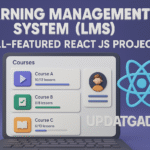
Advanced Ensemble Classifiers
Ensemble Classifiers
In the rapidly evolving world of machine learning, ensemble classifiers have emerged as one of the most effective strategies to enhance prediction accuracy and model robustness. As data continues to grow in volume and complexity, traditional single-model approaches often fall short. This is where advanced ensemble methods step in—offering powerful solutions for modern data challenges across finance, healthcare, NLP, and more. In this post, we’ll explore advanced ensemble classifiers, their strengths and limitations, and their real-world applications.
Machine Learning Tutorial:-Click Here
Data Science Tutorial:-Click Here
Complete Advance AI topics:- CLICK HERE
DBMS Tutorial:-CLICK HERE
What Are Ensemble Classifiers?
Ensemble classifiers work on a simple yet powerful principle: combine multiple base models to produce better predictive performance than any individual model alone. By aggregating the insights of several learners, these methods aim to reduce bias, variance, and overall prediction error. They are especially useful when individual models struggle to generalize across complex, high-dimensional datasets.
Ensemble learning is a cornerstone in fields such as natural language processing, financial modeling, and medical diagnostics—where precision and generalizability are critical.
Types of Advanced Ensemble Classifiers
1. Random Forest
Random Forest is a classic yet powerful ensemble method that constructs numerous decision trees during training and outputs the mode of their predictions. Its strengths include resistance to overfitting and the ability to manage high-dimensional data with ease.
2. Gradient Boosting Machines (GBM)
GBM builds models sequentially—each new learner corrects the errors of the previous ones. By optimizing a loss function iteratively, GBMs deliver high accuracy. Frameworks like XGBoost, LightGBM, and CatBoost have made GBM widely adopted in real-world ML competitions and production systems.
3. AdaBoost (Adaptive Boosting)
AdaBoost adjusts the weights of misclassified instances in each iteration, pushing subsequent learners to focus on difficult cases. It’s simple yet effective for tasks where precision is essential and noise is limited.
4. Stacked Generalization (Stacking)
Stacking goes beyond basic aggregation methods. It trains a meta-model to combine the outputs of base models, allowing the system to capture complex inter-model relationships. It often results in superior performance but can be computationally intensive.
Additional Techniques and Variants
Stacking
In stacking, multiple base learners are trained, and their outputs are used as input features for a final meta-learner. While it can significantly boost accuracy, especially when using diverse models, it may also increase complexity and reduce transparency.
Popular implementation: StackingClassifier (scikit-learn)
Blending
Blending is a simplified form of stacking, where predictions from base learners are combined using weighted averages or majority voting. It is less computationally demanding but can be sensitive to blending strategy.
Popular implementation: BlendingClassifier (TPOT)
Heterogeneous Ensembles
These combine fundamentally different types of models—like decision trees and neural networks—to capture diverse patterns. Although powerful, their construction and tuning demand more effort.
Custom implementations often leverage multiple libraries (e.g., scikit-learn + TensorFlow).
Multi-Objective Optimization
Rather than optimizing solely for accuracy, this approach may prioritize other metrics such as minimizing false positives or boosting recall for minority classes. It’s particularly useful in high-stakes domains but typically requires custom configurations.
Advanced Boosting Techniques
These expand upon traditional boosting with features like regularization, advanced tree pruning, and categorical handling. Examples include LightGBM, CatBoost, and XGBoost, offering faster training and improved scalability.
Real-World Applications
1. Financial Forecasting
Ensemble classifiers help analysts and algorithmic traders forecast market trends, manage portfolios, and mitigate risk. Their ability to model complex, nonlinear relationships is crucial in high-volatility environments.
2. Medical Diagnosis
In healthcare, ensembles are used for disease prediction, patient risk classification, and decision support systems. Integrating varied data—from medical imaging to genetic markers—enables more comprehensive and accurate diagnoses.
3. Natural Language Processing (NLP)
Tasks such as sentiment analysis, spam detection, and topic modeling benefit from ensembles’ ability to capture context and linguistic nuances. Stacking and boosting methods often lead to superior performance in NLP pipelines.
Key Challenges
Scalability
Handling massive datasets demands distributed computing and optimized algorithms. Without this, training complex ensembles can become computationally prohibitive.
Interpretability
While ensemble models excel in accuracy, they often lack transparency. Efforts are ongoing to develop interpretable ensembles that balance performance with explainability.
Model Selection & Diversity
Choosing the right mix of base learners is non-trivial. Increasing model diversity typically improves ensemble performance but also adds complexity.
Imbalanced Data
Ensembles may be biased toward the majority class. Techniques like cost-sensitive learning, balanced bagging, and resampling can help address this issue.
Domain Knowledge Integration
Incorporating expert insights into ensemble design can improve generalization and trust. However, integrating such constraints remains an underexplored research area.
Complete Python Course with Advance topics:-Click Here
SQL Tutorial :-Click Here
Download New Real Time Projects :-Click here
Conclusion
Advanced ensemble classifiers are shaping the next frontier in machine learning. Their flexibility, adaptability, and superior performance make them indispensable tools in data-driven industries. As data grows more complex, the need for sophisticated ensemble methods will only intensify. At Updategadh, we believe embracing these cutting-edge techniques is key to unlocking the future of predictive analytics.
ensemble learning algorithm examples
ensemble techniques in machine learning
types of ensemble learning
ensemble learning in machine learning – javatpoint
ensemble learning in machine learning – geeksforgeeks
ensemble learning techniques
advantages and disadvantages of ensemble learning
ensemble models examples
advanced ensemble classifiers in machine learning
advanced ensemble classifiers python
ensemble learning in machine learning javatpoint










Post Comment